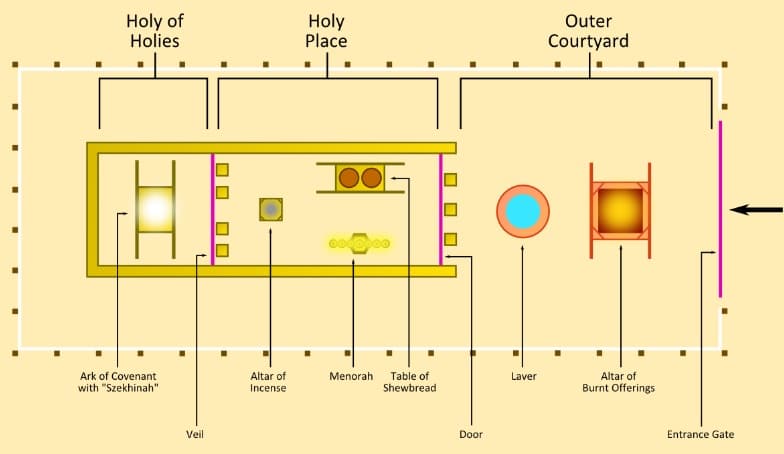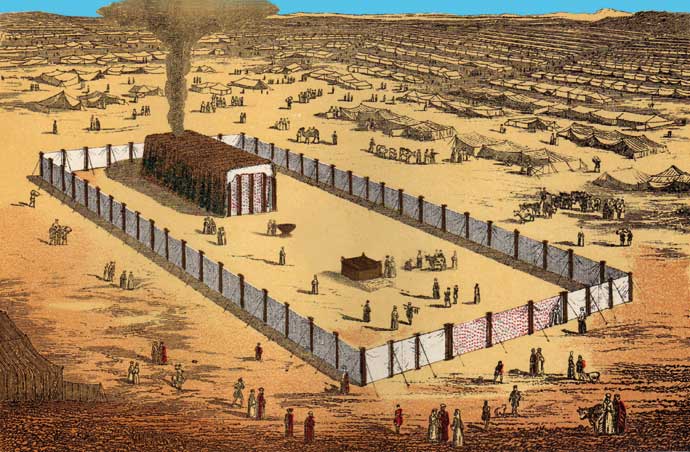We are concluding this Tabernacle 101 Series, where God began. At the beginning, we were on the outside of the portable worship center – looking in. We have followed the Hebrew worshipper with their animal-for-sacrifice to the entrance of the tabernacle courtyard, and we have seen the priests functioning at the large bronze altar and their preparations at the laver. The Jew could go no further.
Only the priests from the tribe of Levi could have access to the interior; no one else was allowed inside the tent where the Table of Shewbread, the Gold Lampstand and the Altar of Incense were. And then there was that heavy-duty, somewhat spectacular curtain (veil) that separated the Holy Interior from the Holy of Holies. Behind that curtain, not even the priests themselves could enter. After all – it was the Holy of Holies. In this Holy Chamber rested the Ark of the Covenant with its pure gold cover – called the Mercy Seat.
Who had access to this inner sanctuary? Perhaps it is not 100% correct to answer: ‘only the High Priest once a year.’ As you read your Bible carefully, you may conclude that Moses had 24/7 access to the Mercy Seat in the Holy of Holies. (Exodus 25:22, Numbers 7:89, Psalm 99:6) It’s safe to say, other than Moses, no one other than the High Priest had access to the Mercy Seat – and only once a year and not without blood.
We have briefly studied the Ark of the Covenant. Perhaps you’ve been able to find the six other names given to the Ark in the Old Testament. It was a rectangular-shaped chest made of acacia wood and covered with gold inside and out. But the cover of the chest was a separate piece designed to snugly and securely fit on the top of the chest, concealing the contents inside. This piece was known as the Mercy Seat or the Atonement Cover.

“You shall make a mercy seat of pure gold. Two cubits and a half shall be its length ( 45 inches long), and a cubit and a half its breadth (27 inches wide). And you shall make two cherubim of gold; of hammered work shall you make them, on the two ends of the mercy seat. Make one cherub on the one end, and one cherub on the other end. Of one piece with the mercy seat shall you make the cherubim on its two ends. The cherubim shall spread out their wings above, overshadowing the mercy seat with their wings, their faces one to another; toward the mercy seat shall the faces of the cherubim be. And you shall put the mercy seat on the top of the ark, and in the ark you shall put the testimony that I shall give you. There I will meet with you, and from above the mercy seat, from between the two cherubim that are on the ark of the testimony, I will speak with you about all that I will give you in commandment for the people of Israel. (Exodus 25:17-22)
The mercy seat was a slab of pure gold. No wood or any other material – just pure gold. No one today knows for sure what the cherubim looked like at both ends of the slab, but these two golden figurines had faces and wings, and it seems they were beaten out of the same slab of gold – not made as attachments to be installed. No easy feat, even for a skilled craftsman or goldsmith. No – these artisans were specially equipped and enabled by God Himself to construct such things of Divine significance and design. (Exodus 31:1-5)

It’s reassuring to know our secure salvation originated with God, and every detail was according to His purpose and plan. The Apostle Peter wrote about Christ: “He was foreknown before the foundation of the world but was made manifest in the last times for the sake of you who through Him are believers in God, who raised Him from the dead and gave Him glory, so that your faith and hope are in God.” 1Peter 1:20-21.
What, in the material of the mercy seat, would make you think of the uncompromised deity of the Lord Jesus Christ? Pure gold. Solid gold. Everything rests on Who He is.
Below the slab of gold, was the Law of God – the Ten Commandments on the tables of stone inside the chest. The only One who, always – without exception, delighted to do all the will of God and obey the Law of God – was Christ Himself. Do you have this verse underlined in your Bible – Psalm 40:8? “Christ, the Ark ‘contained’ the Law – He magnified it and made it honourable. (John 4:34, 6:38; Romans 10:4)” (1)
The term ‘mercy seat’ (in Hebrew – kapporeth) means ‘propitiatory.’ You can delve deeper into the significance of the terms propitiation and atonement but for our purposes, let’s just say it means – to appease, to placate, or to make satisfaction. People sometimes split theological hairs over the difference between the Old Testament word atonement and the New Testament word propitiation. You can visit Truth and Tidings website and do your own search of these two words for further development.
But back to the Atonement Cover or the Mercy Seat – “This is where propitiation was made for the sins of the people. On this basis only, God could show ‘mercy’ to the nation. Propitiation, for our appreciation, is the truth that the Lord Jesus satisfied God’s righteous claims and character concerning the issue of sin; in doing so, He made provision for every human to have and to know their sins forgiven and to enjoy fellowship with God.” (2)
You can read the entire chapter outlining the once-a-year process when the high priest went behind the curtain and approached the mercy seat. But here is one verse from Leviticus 16:
And he [High Priest] shall take some of the blood of the bull and sprinkle it with his finger on the front of the mercy seat on the east side, and in front of the mercy seat he shall sprinkle some of the blood with his finger seven times. (Leviticus 16:14)
So, the blood was absolutely essential! Did you notice that those two cherubim were designed to be facing each other with their heads looking down to the gold slab where the blood of the sacrifice was sprinkled? By the way, why two cherubim? Hint: Deuteronomy 19:15, Matthew 18:16
Cherubim, in the Bible, are closely linked to God’s throne and matters related to justice and government. It seems the lesson here from their position on the gold slab is their occupation with God’s demands and His righteous claims. They uphold God’s judicial authority. They are staring down at the blood of the innocent victim – looking intently on what has met and satisfied God’s every claim. The blood is the evidence that justice has been carried out and judgment has done its work. Justice is satisfied.
Yes, this was God’s meeting place with His people. Only a blood sacrifice could meet the demands of the law that was broken and allow Him to continue to be present among His people. Today, “the great propitiation which Christ made through His death, is enough to satisfy the Throne of God and permit Him to meet poor sinners in all the fullness of His grace. Romans 3:25, 1 John 2:2; 4:10” (3)
“The mercy seat was God’s throne on earth. (1Samuel 4:4, 2Samuel 6:2, 2Kings 19:15) It rested on the Ark of the Covenant and speaks to our hearts of the rest and satisfaction which God now enjoys in His Son in Heaven as the result of His finished work and shed blood. (Hebrews 9:14; 13:11-12) God’s throne in Heaven is now called a throne of grace.” (4)
Before we conclude this lesson and this series, think of the huge contrast between the Old Testament Tabernacle system and what is ours today in Christ. Back then, their High Priest could only enter that very holy place once a year on the Day of Atonement – and no one other than Moses was ever allowed in during the other 364 days of the year. Here’s our situation today:
So then, since we have a great High Priest who has entered heaven, Jesus the Son of God, let us
hold firmly to what we believe. This High Priest of ours understands our weaknesses, for He faced all of the same testings we do, yet He did not sin. So let us come boldly to the throne of our gracious God. There we will receive His mercy, and we will find grace to help us when we need it most. Hebrews 4:14-16 NLT
“This is possible because our Great High Priest is in the presence of God continually. Not once a year, but in every time of need, the believer is able to resort to the Presence of God for solace, succour and support.” (5)
CONCLUSION –
Whatever became of the tabernacle set-up that started in the wilderness? It was brought into the Promised Land. During the time of the Judges, it was located in Shiloh. (Joshua 18:1). When Saul was reigning as King, it was at Nob (1Samuel 21) and then later at Gibeon (1Chronicles 16:39). In 2Samuel 6:17-20, David brought the Ark of the Covenant only and stationed it inside a tent he erected in Jerusalem – Mount Zion. Finally, when the long-awaited-for Temple was completed in Jerusalem, King Solomon reunited the Ark of the Covenant with the ‘tabernacle’ and all the other pieces of furniture and accessories and set it up inside the new temple. (1 Kings 8:4) That’s some history. But finally —-
Remember all that we have studied about the ancient tabernacle and much of what we didn’t mention – all of it is considered a shadow. The substance is Christ. If you were a mother, which would you rather have: a picture of your son on the wall or your son in your home? Dear Child of God – yes, we are seated with Christ in the heavenly realms (Ephesians 2:6), but in another very real sense, we have Christ dwelling in our hearts through faith. (Ephesians 3:17) Saturate your mind with sweet thoughts of Christ as you read and study your Bible. The more of Christ I enjoy, the stronger Christian I will be.
SOURCES:
- Tabernacle Studies: The Ark and the Mercy Seat, Truth and Tidings, Sydney Maxwell, February 2005
- Monday Meditations, Dr. A. J. Higgins
- Tabernacle Studies: The Ark and the Mercy Seat, Truth and Tidings, Sydney Maxwell, February 2005
- ibid.
- ibid.


Sorry to see this study come to an end. It has so blessed my heart. My appreciation for the pictures of Christ in the OT has risen dramatically. Thank you so much. Maybe there will be a new study soon. Ada J. Moncton
This study was very good.. enjoyable.. thanks for doing this..sb
It was spiritually beneficial for me to go through the Tabernacle material again. Glad you were able to enjoy it too. Thanks for the encouragement.
We have just completed the series and have really enjoyed it. Much of it we knew but it was good to have a refresher course. And we were made to think again about some verses. For example, we have often read Heb 10.20 but your thoughts on the tearing of the veil made us think about it in a way we haven’t before. Thank you.